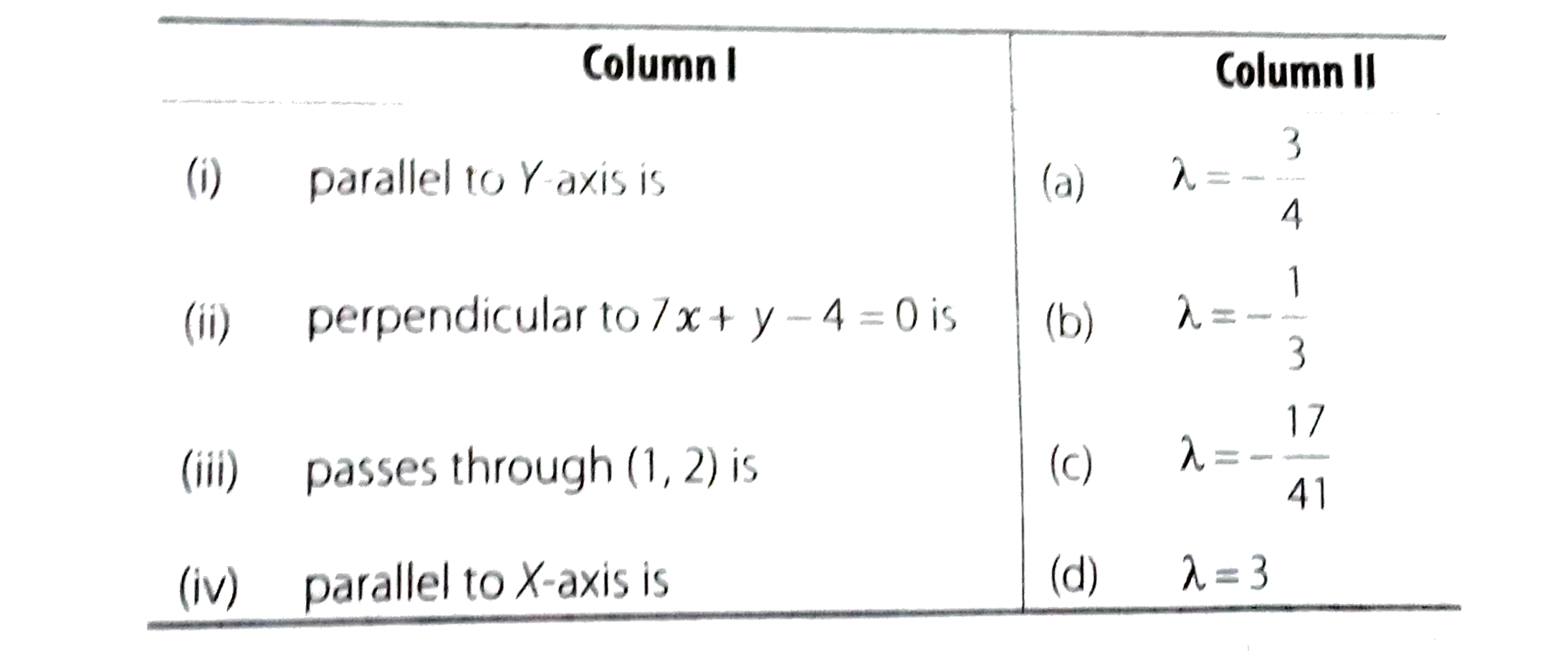The sum of all the values of for which the set contains exactly one element is
31
12
The correct Answer is:C
To solve the problem, we need to find the sum of all values of λ for which the intersection of the sets defined by the circle and the line contains exactly one point. This implies that the line is tangent to the circle.
Step 1: Identify the Circle Equation
The given equation of the circle is:
x2+y2−6x+4y=12
We can rewrite this in standard form by completing the square.
Step 2: Complete the Square
1. For x2−6x, we complete the square:
x2−6x=(x−3)2−9
2. For y2+4y, we complete the square:
y2+4y=(y+2)2−4
3. Substitute back into the circle equation:
(x−3)2−9+(y+2)2−4=12
Simplifying gives:
(x−3)2+(y+2)2=25
Step 3: Identify the Center and Radius
From the standard form (x−h)2+(y−k)2=r2:
- Center (h,k)=(3,−2)
- Radius r=5
Step 4: Write the Line Equation
The line is given by:
4x+3y=λ
We can rewrite this in standard form:
4x+3y−λ=0
Step 5: Calculate the Distance from the Center to the Line
The distance d from a point (x0,y0) to the line Ax+By+C=0 is given by:
d=|Ax0+By0+C|√A2+B2
Here, A=4, B=3, C=−λ, and the center (x0,y0)=(3,−2).
Calculating the distance:
d=|4(3)+3(−2)−λ|√42+32=|12−6−λ|√16+9=|6−λ|5
Step 6: Set the Distance Equal to the Radius
For the line to be tangent to the circle, the distance must equal the radius:
|6−λ|5=5
Multiplying both sides by 5 gives:
|6−λ|=25
Step 7: Solve the Absolute Value Equation
This gives us two cases:
1. 6−λ=25
λ=6−25=−19
2. 6−λ=−25
λ=6+25=31
Step 8: Sum the Values of λ
Now, we sum the two values:
−19+31=12
Final Answer
The sum of all values of λ for which the intersection contains exactly one element is:
12
The given equation of the circle is:
x2+y2−6x+4y=12
We can rewrite this in standard form by completing the square.
1. For x2−6x, we complete the square:
x2−6x=(x−3)2−9
2. For y2+4y, we complete the square:
y2+4y=(y+2)2−4
3. Substitute back into the circle equation:
(x−3)2−9+(y+2)2−4=12
Simplifying gives:
(x−3)2+(y+2)2=25
From the standard form (x−h)2+(y−k)2=r2:
- Center (h,k)=(3,−2)
- Radius r=5
The line is given by:
4x+3y=λ
We can rewrite this in standard form:
4x+3y−λ=0
The distance d from a point (x0,y0) to the line Ax+By+C=0 is given by:
d=|Ax0+By0+C|√A2+B2
Here, A=4, B=3, C=−λ, and the center (x0,y0)=(3,−2).
d=|4(3)+3(−2)−λ|√42+32=|12−6−λ|√16+9=|6−λ|5
For the line to be tangent to the circle, the distance must equal the radius:
|6−λ|5=5
Multiplying both sides by 5 gives:
|6−λ|=25
This gives us two cases:
1. 6−λ=25
λ=6−25=−19
2. 6−λ=−25
λ=6+25=31
Now, we sum the two values:
−19+31=12
The sum of all values of λ for which the intersection contains exactly one element is:
12
Similar Questions
The value of 'c' for which the set {(x,y)∣x2+y2+2x≤1}∩{(x,y)∣x−y+c≤0} contains only one point in common is
View SolutionThe values of λ for which the system of euations x+y+z=6x+2y+3z=10x+2y+λz=12 is inconsistent
View SolutionThe set of all values of λ for which the system of linear equations
x−2y−2z=λx
x+2y+z=λy
−x−y=λz
has a non-trivial solution
View SolutionThe range of values of λ for which the circles x2+y2=4 and x2+y2−4λx+9=0 have two common tangents, is
View SolutionThe range of values of λ for which the circles x2+y2=4 and x2+y2−4λx+9=0 have two common tangents, is
View SolutionThe value of the λ if the lines (2x+3y+4)+λ(6x−y+12)=0 are

View SolutionThe value of λ for which the circle x2+y2+2λx+6y+1=0 intersects the circle x2+y2+4x+2y=0 orthogonally, is
View SolutionThe pole of 2x+3y=0 with respect to x2+y2+6x−4y=0 is
View SolutionFind the products: (3x+2y)(9x2−6xy+4y2)
View SolutionThe value of 'λ' so that the system of equations x+2y+3=0 3x+4y+4=0 7x−10y+λ=0 is consistent, is
View Solution